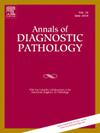Prognostic significance of CD3+ and CD8+ T-cells immunoscore in renal cell carcinoma: A comparison between two simple models for assessment
IF 1.5
4区 医学
Q3 PATHOLOGY
引用次数: 0
Abstract
The immunoscore (ISc) has been extensively investigated as a prognostic indicator for numerous solid tumors. In renal cell carcinoma (RCC), its prognostic significance has been evaluated in a small number of studies. This study was designed to ascertain the prognostic value of ISc based on CD3+ and CD8+ T cells in patients with RCC. This study included 115 non-metastatic RCC patients who underwent nephrectomy. The ISc was obtained by estimating the densities of CD3+ and CD8+ cells at the invasive margin and center of the tumor using two methods: cell count per square millimeter (cell count/mm2) and percentage of cells per square millimeter (% of cells/mm2). The patients were categorized into low and high groups according to the ISc. The associations between the ISc and clinicopathological characters, including survival, were analyzed statistically. Adverse clinicopathologic factors were significantly associated with high ISc. Patients with high ISc had significantly worse overall survival (OS) and disease-free survival (DFS) rates over three years (p < 0.001). High ISc was considered a predictor of shortened DFS in univariate analysis (p < 0.001). However, in multivariate analysis, it was a dependent predictor. High ISc could help identify individuals more likely to develop recurrence and may impact treatment strategy for more effective personalized care. Moreover, establishing a modified objective, automated, digital quantification method of immune cells (% of cells/mm2 instead of cell count/mm2) is expected to be simple to implement in routine, highly affordable, time efficient, clinically meaningful, and will improve assay performance.
肾细胞癌中 CD3+ 和 CD8+ T 细胞免疫评分的预后意义:两种简单评估模型的比较。
免疫评分(ISc)作为许多实体瘤的预后指标已被广泛研究。在肾细胞癌(RCC)中,只有少数研究对其预后意义进行了评估。本研究旨在确定基于 CD3+ 和 CD8+ T 细胞的 ISc 对 RCC 患者的预后价值。这项研究纳入了115名接受肾切除术的非转移性RCC患者。ISC是通过估算肿瘤浸润边缘和中心的CD3+和CD8+细胞密度得出的,采用了两种方法:每平方毫米细胞计数(细胞计数/mm2)和每平方毫米细胞百分比(细胞百分比/mm2)。根据 ISc 将患者分为低度组和高度组。统计分析了 ISc 与临床病理特征(包括存活率)之间的关系。不良临床病理因素与高ISc显著相关。高 ISc 患者三年内的总生存率(OS)和无病生存率(DFS)明显较差(p 2)。
本文章由计算机程序翻译,如有差异,请以英文原文为准。
求助全文
约1分钟内获得全文
求助全文
来源期刊
CiteScore
3.90
自引率
5.00%
发文量
149
审稿时长
26 days
期刊介绍:
A peer-reviewed journal devoted to the publication of articles dealing with traditional morphologic studies using standard diagnostic techniques and stressing clinicopathological correlations and scientific observation of relevance to the daily practice of pathology. Special features include pathologic-radiologic correlations and pathologic-cytologic correlations.

 求助内容:
求助内容: 应助结果提醒方式:
应助结果提醒方式:


